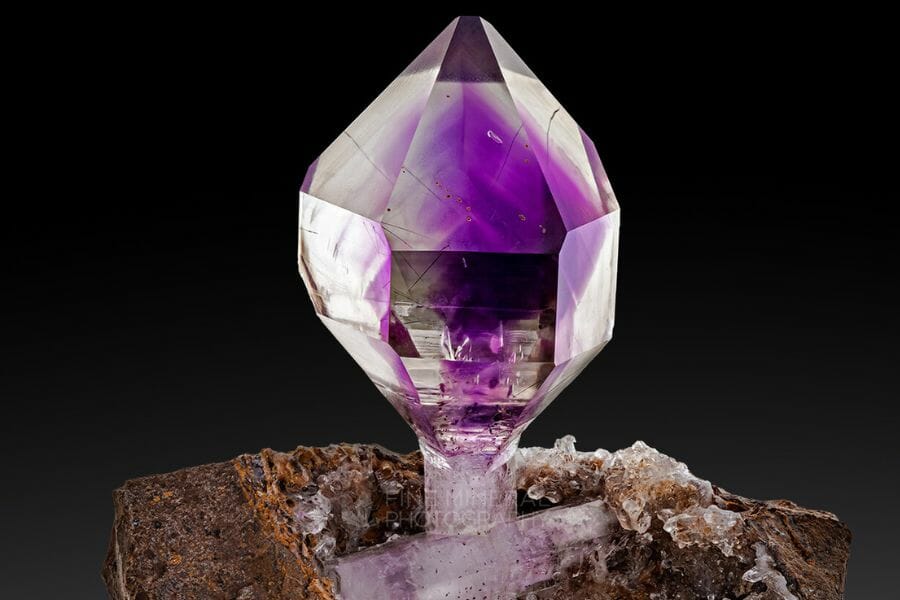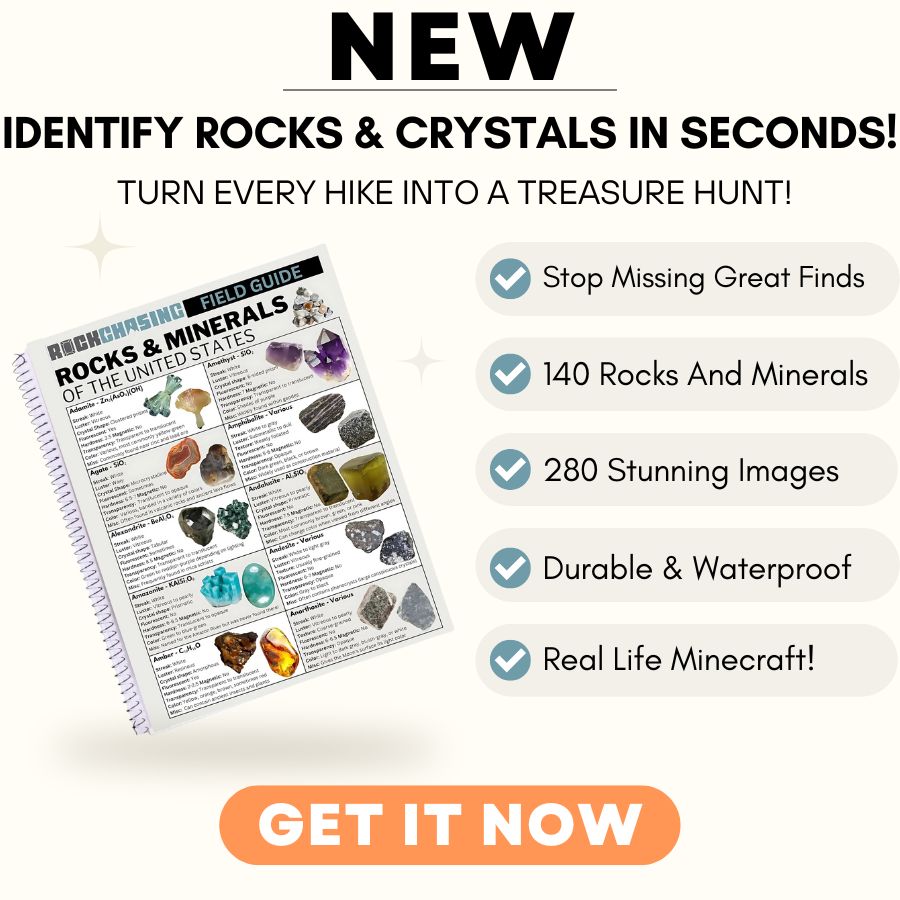Amethyst, with its deep purple beauty, has been a favorite of gem hunters for ages. Our state is a treasure trove for these stunning crystals, hiding them in its varied landscapes.
Whether you’re a seasoned rock hound or just starting out, the thrill of finding your own Amethyst is hard to beat.
In this article, we’ll take you on a journey through the best places in our state to hunt for these purple wonders. We’ll also share some handy tips to make your search more fun and successful.
So grab your gear and get ready to explore – there’s Amethyst waiting to be found!
How Amethyst Forms Here

Amethyst forms deep underground, where lava cools slowly inside large pockets. These pockets, often called geodes, fill with hot water full of minerals, especially silica.
Over time, the silica-rich water reacts with iron, creating the purple color. As the water cools and evaporates, it leaves behind crystals. These crystals grow over millions of years, layer by layer, forming amethyst.
The purple shade can vary depending on the amount of iron present and the temperature during formation.
The slow cooling process is key to creating the distinct, vibrant purple color that makes amethyst so unique and beautiful.
The Types Of Amethyst
Amethyst comes in multiple stunning types each with its unique beauty. Here are some of the types of Amethyst:
Cactus Amethyst

Cactus Amethyst, also known as Spirit Quartz, looks like a tiny crystal garden. It has a big crystal in the middle, surrounded by lots of smaller crystals. This gives it a sparkly, glittery look that catches the eye.
The colors can vary a lot. You might see purple, orange, yellow, or even clear crystals. Each piece is unique, with its own mix of colors and crystal shapes.
Its special growth pattern makes it different from regular amethyst. The “cactus-like” look is why it got its name. Crystal fans love it because each piece is one-of-a-kind.
Prasiolite

Prasiolite is a green amethyst that grabs attention with its unique color. It ranges from pale mint to deep olive green, standing out from its purple cousin, amethyst.
Most prasiolite in stores is made by heating amethyst or using special light treatments. This process changes the stone’s color from purple to green. Natural green prasiolite is quite rare.
Prasiolite offers a cheaper option for those who like green gems but find emeralds too pricey.
Chevron Amethyst

Chevron Amethyst stands out with its eye-catching V-shaped pattern. This stone combines white quartz and purple amethyst in alternating layers, creating a striking banded look.
The layers can be opaque or see-through, giving each piece a unique character. Its surface feels rough and bumpy, adding to its distinctive charm.
People often call it “Dogtooth Amethyst” or “Banded Amethyst” because of its special appearance.
It forms when silica-rich fluids fill spaces in volcanic rocks, resulting in its signature chevron pattern. Collectors love it for its rarity and unique look.
Ametrine

Ametrine is a show-stopper with its two-tone look. It combines the purple of amethyst and the yellow of citrine in one stone. The colors can blend gradually or have a sharp divide, making each piece unique.
High-quality ametrine is clear and free from flaws, letting light enhance its colors. Jewelers often cut it to show off the color split, creating eye-catching designs.
What makes ametrine special is how it forms. Changes in heat and pressure during its growth cause the two-color effect.
It’s the only gem that naturally combines amethyst and citrine, making it a favorite among rock enthusiasts.
Brandberg Amethyst
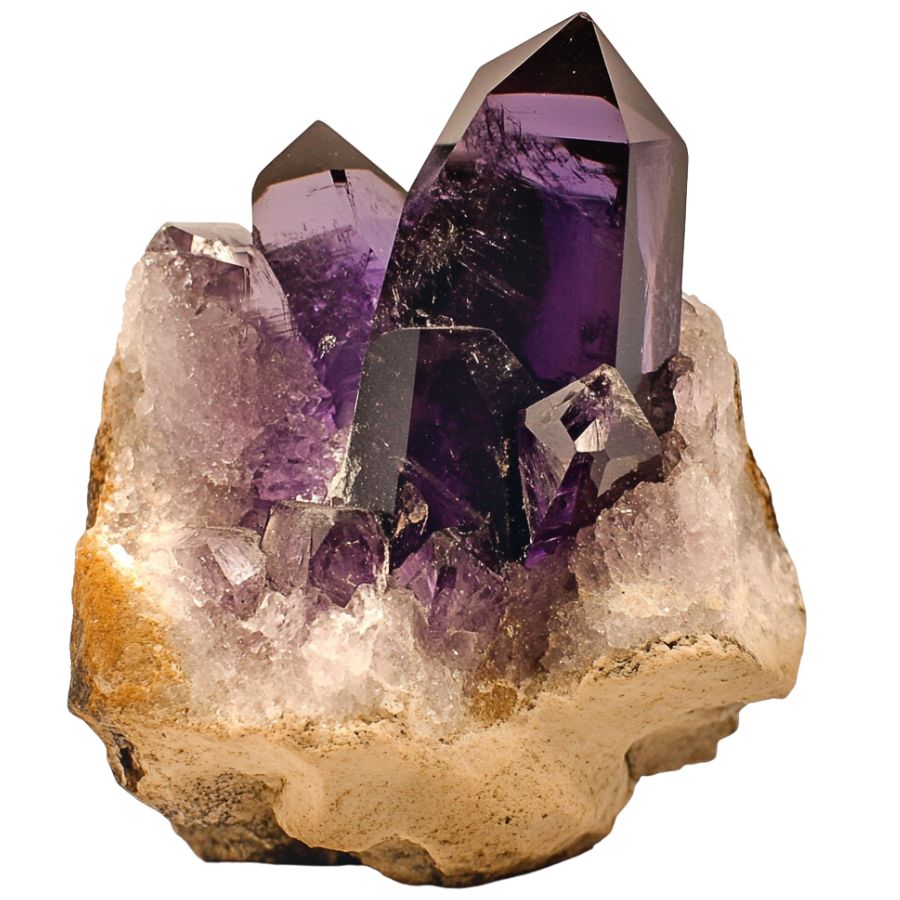
Brandberg Amethyst showcases a stunning range of colors, from light to deep purple, often mixed with smoky and clear quartz. You might spot red and silver hematite inclusions, adding to its charm.
These crystals come in various shapes, including single pieces, clusters, and unique skeletal growths. They’re known for their glass-like clarity and interesting internal structures, like phantoms and zoning.
What makes Brandberg Amethyst special is its combination with smoky quartz, which you don’t usually see in other amethysts.
The crystal formations are more defined and varied. It’s also quite old, forming in volcanic basalt estimated to be 132-135 million years old.
Cacoxenite Amethyst

Cacoxenite Amethyst combines deep purple amethyst with golden or brown cacoxenite inclusions. These inclusions look like tiny threads or tufts, creating a cool layered effect.
Each piece of Cacoxenite Amethyst is unique. The mix of purple and gold makes for some truly one-of-a-kind stones. No two pieces look exactly the same.
This stone is part of the “Super Seven” group, which includes seven different minerals in one stone. That makes it pretty special among rock collectors. Its rarity and unique look make it a favorite for those who love unusual stones.
Pink Amethyst
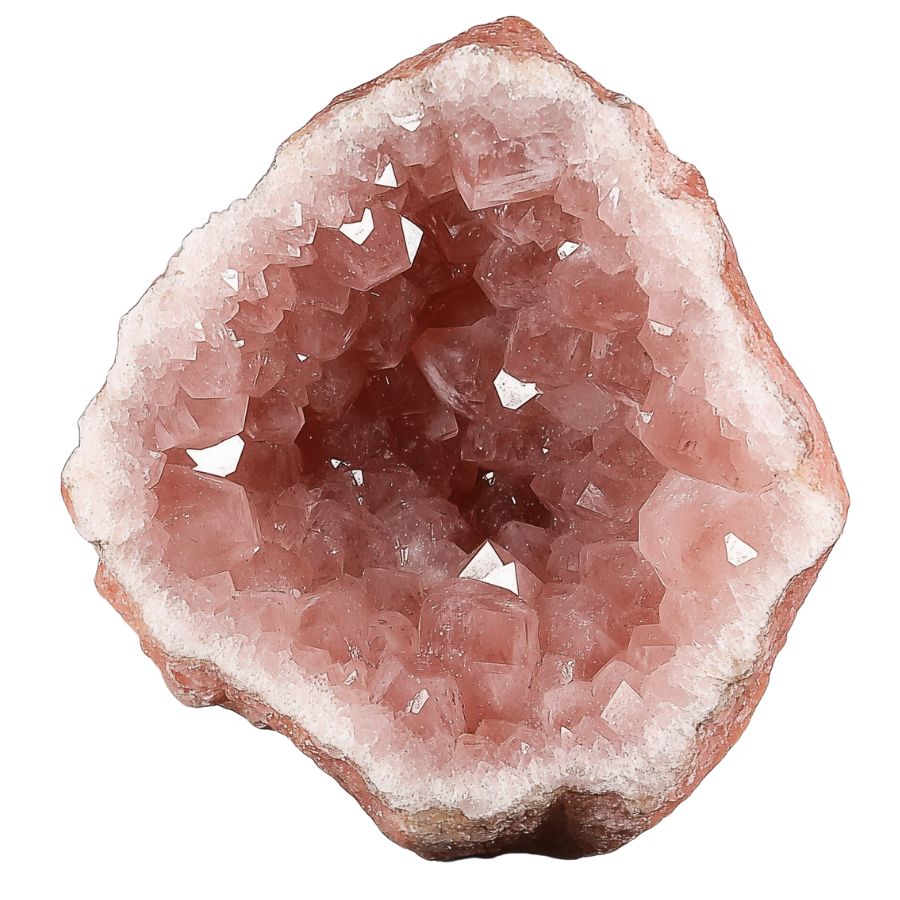
Pink Amethyst stands out with its soft pink to dusty rose color. It’s different from regular purple amethyst and even from rose quartz. The color comes from tiny bits of hematite inside the crystal.
This stone was only discovered in 2019, making it a newcomer in the gem world. Its recent discovery and unique color have made it quite popular among rock enthusiasts.
Pink Amethyst often has subtle patterns and sparkles, especially in sunlight. This makes it look really pretty. The way it forms is special too. The hematite mixes in while the crystal is growing, creating its unique pink shade.
Phantom Amethyst

Phantom Amethyst has a cool ghost-like appearance inside. These “phantoms” are layers of different minerals, often including smoky quartz. The color can be deep purple or light lavender.
When you look at it, you’ll see distinct layers inside. This layered look makes it different from regular amethyst. Some pieces might have color zones or internal cracks, which actually make them more interesting.
These stones tell a story of how they grew over time. Each layer shows a different stage of growth. This makes Phantom Amethyst popular with people who like to collect interesting rocks and learn about how they form.
Scepter Amethyst

Scepter Amethyst looks like a tiny royal scepter or wand. It has a thick bottom that gets skinnier towards the top, often with a distinct head. The color can be deep purple or light lavender, and it’s usually very clear and shiny.
What makes it special is how it forms. A bigger crystal grows around a smaller one, creating that unique scepter shape. This doesn’t happen often, so these stones are pretty rare.
Sometimes, you can find tiny bubbles or other minerals trapped inside the crystal. These little extras make each Scepter Amethyst unique. People who collect rocks love them because they’re so different from regular amethyst.
Smoky Amethyst

Smoky Amethyst is a mix of purple amethyst and brown or grey smoky quartz. This blend gives it a unique look. Some pieces might be more purple, while others are more smoky-colored.
This stone is pretty rare, which makes it special. It was only discovered in 2018, so it’s quite new in the rock world. Its dark color and sometimes the presence of other minerals inside make it stand out.
Smoky Amethyst combines features from both amethyst and smoky quartz. This mix makes it interesting for people who collect rocks. Its rarity and unique appearance have made it popular among those who love unusual stones.
What Rough Amethyst Looks Like
When collecting raw amethyst, it’s crucial to know what to look for. Here are some tips to help you identify authentic raw amethyst:
Look for the Purple Color

Rough amethyst usually has a distinct purple color, ranging from light lavender to deep violet.
The color might not be uniform and can appear patchy, with lighter or darker spots. If you find a rock with hints of purple, it’s worth a closer look.
Check for a Glassy or Waxy Luster

Rough amethyst usually has a glassy or slightly waxy look. When you hold it, tilt it in the light.
If it shines and reflects light well, that’s a good sign. A dull surface might mean it’s not real amethyst.
Notice the Crystal Structure
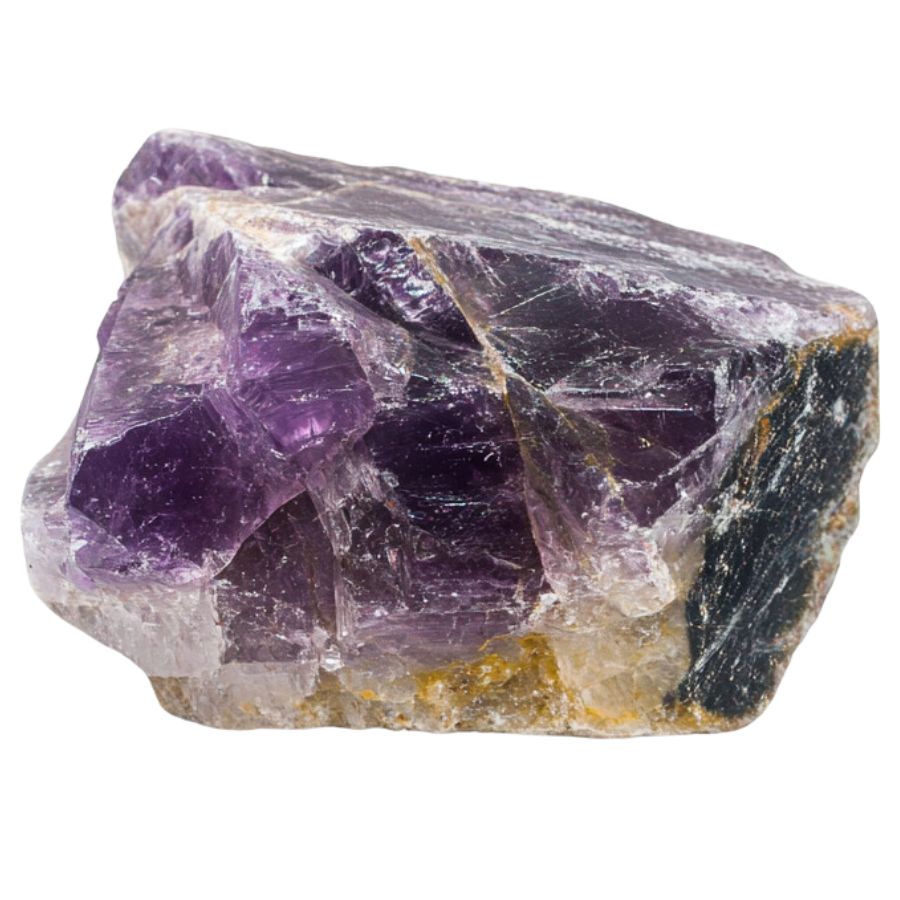
Amethyst typically forms in hexagonal shapes, which can be visible even in rough pieces. Look for sharp angles and flat faces.
The crystals may be small or clustered together, but the geometric structure is a good clue that you’ve found amethyst.
Assess the Density and Weight

Pick up the stone. Amethyst is denser than many other rocks. If it feels light, it might be a fake.
Real amethyst is dense, so if it feels substantial in your hand, you’re likely on the right track.
A Quick Request About Collecting
Always Confirm Access and Collection Rules!
Before heading out to any of the locations on our list you need to confirm access requirements and collection rules for both public and private locations directly with the location. We haven’t personally verified every location and the access requirements and collection rules often change without notice.
Many of the locations we mention will not allow collecting but are still great places for those who love to find beautiful rocks and minerals in the wild without keeping them. We also can’t guarantee you will find anything in these locations since they are constantly changing.
Always get updated information directly from the source ahead of time to ensure responsible rockhounding. If you want even more current options it’s always a good idea to contact local rock and mineral clubs and groups
Tips on where to look
Once you get to the places we have listed below there are some things you should keep in mind when you’re searching:
Search Near Old Mines

Old mines are great places to find amethyst. Many mines have leftover material where you might spot purple crystals.
Even if a mine isn’t actively used, you can often find amethyst in the surrounding areas.
Explore Riverbeds

Riverbeds can be rich hunting grounds for amethyst. Over time, water carries rocks and minerals, depositing them in riverbeds.
Look for purple stones among the gravel and along the edges where the water slows down.
Check Hillsides and Slopes

Hillsides is another good spot. When rocks weather and break down, amethyst can be revealed on slopes. Pay attention to loose rocks and exposed areas.
Search in Local Gravel Pits

Gravel pits are another good option. These areas are often dug up for construction materials.
Sometimes, amethyst can be found mixed in with the gravel. Always ask for permission before exploring these sites.
The Best Spots To Find Amethyst in Arizona
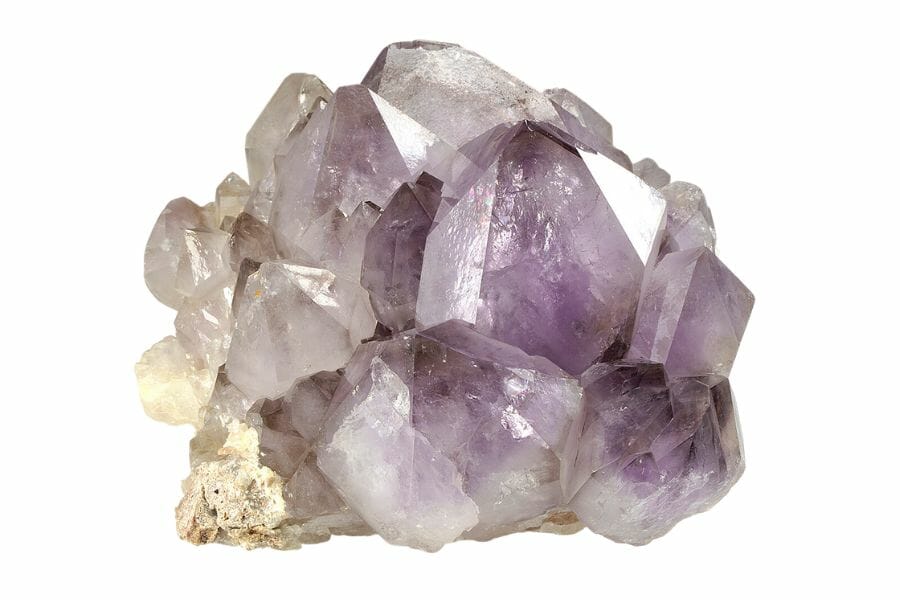
These are our best recommendations for finding amethysts in Arizona. There are many unique places to mine for gems in Arizona, but just a few are particularly good for discovering amethyst. While searching, we found fascinating options in these locations despite some of them not being well-known.
Always Confirm Access and Collection Rules!
Before heading out to any of the locations on our list you need to confirm access requirements and collection rules for both public and private locations directly with the location. We haven’t personally verified every location and the access requirements and collection rules often change without notice.
Many of the locations we mention will not allow collecting but are still great places for those who love to find beautiful rocks and minerals in the wild without keeping them. We also can’t guarantee you will find anything in these locations since they are constantly changing.
Always get updated information directly from the source ahead of time to ensure responsible rockhounding. If you want even more current options it’s always a good idea to contact local rock and mineral clubs and groups
Bell Butte
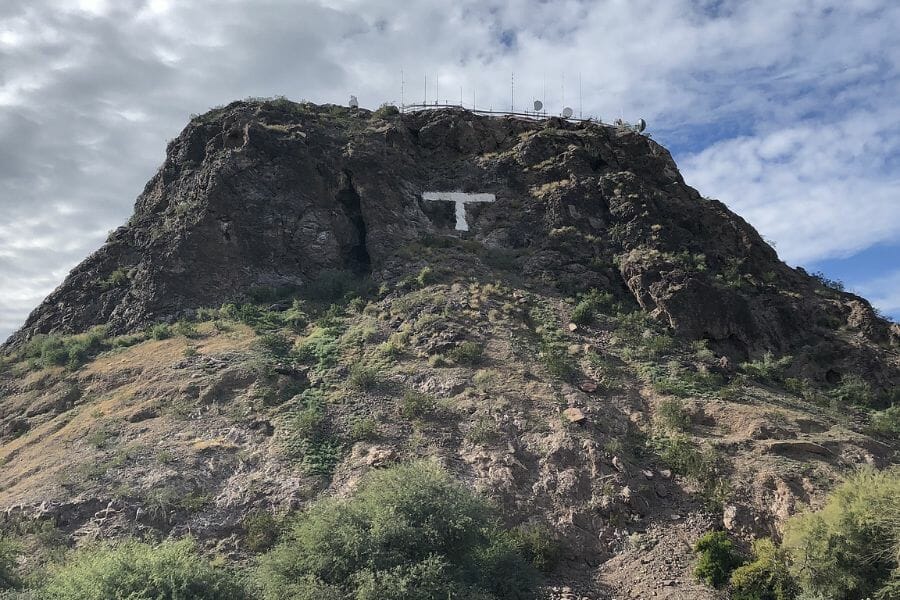
Bell Butte is a stunning natural landmark in Arizona that’s a popular destination for outdoor enthusiasts. This unique geological formation stands out from the surrounding desert landscape and is a great place to escape it all. With an elevation of over 1,200 feet, the butte offers incredible views of the surrounding mountains and desert terrain that are not to be missed.
The climb up Bell Butte may be challenging, but it’s worthwhile. The trail is rocky and steep in places, so it’s important to wear sturdy shoes and bring plenty of water. Along the way, hikers can enjoy the breathtaking scenery and unique rock formations that make Bell Butte a one-of-a-kind destination.
Bell Butte’s geology is a key factor in its amethyst-bearing potential. The butte is composed of basalt, a volcanic rock known to contain amethyst deposits. Additionally, the presence of hot springs in the area suggests that amethysts may be found in the surrounding hillsides and valleys.
Before bringing anything home, be familiar with the most recent Arizona collecting regulations.
Where we found amethyst in the Bell Butte
Amethysts can be found in all areas of the Bell Butte, including its surrounding hillsides and valleys.
DON'T MISS OUT ON ANY GREAT FINDS!
While you're out searching for Amethyst you're going to find A LOT of other interesting rocks and minerals along the way. The last thing you want to do is toss out something really interesting or valuable. It can be easy to misidentify things without a little guidance.
We've put together a fantastic field guide that makes identifying 140 of the most interesting and valuable rocks and minerals you will find REALLY EASY. It's simple to use, really durable, and will allow you to identify just about any rock and mineral you come across. Make sure you bring it along on your hunt!
El Tigre Mine
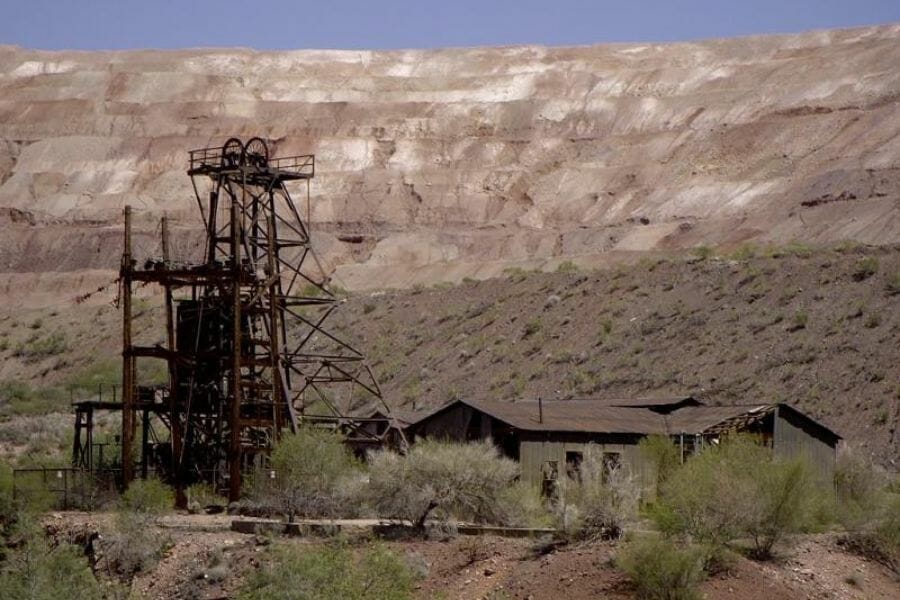
El Tigre Mine is a historic mining site renowned for producing amethysts, a prized variety of quartz. The mine is situated in a remote location and was first established in the early 1900s. Since then, it has been a popular destination for rock hounds and collectors looking for high-quality amethysts.
The surrounding mountains contain volcanic rocks and are known to be rich in minerals, including quartz. The amethysts found at El Tigre Mine are typically a deep, rich purple color and are highly valued by collectors and jewelry designers.
You can take a guided site tour to learn more about its history and geology. The remote location and rugged terrain make it ideal for adventurous rock hunters, but it’s essential to exercise caution and follow any safety precautions.
Where we found amethyst in the El Tigre Mine
Amethysts can be found in and around the El Tigre Mine. We’ve made a detailed article for you to know how much amethysts are worth.
Four Peaks Amethyst Mine
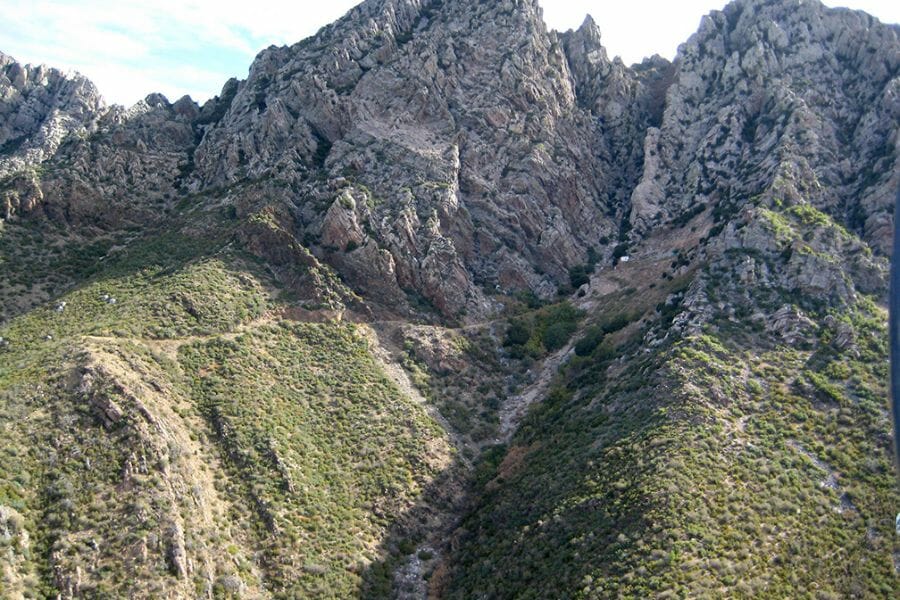
Four Peaks Amethyst Mine is a well-known amethyst mining site in Arizona. It’s a popular destination for rock hounds and gemstone collectors looking for high-quality amethysts. The mine is in the Four Peaks mountain range, known for its unique geology and high mineral content. The mine has operated for over 100 years and has produced some of the world’s finest amethysts.
Four Peaks Amethyst Mine is a prime location to look for high-quality amethysts and experience the beauty of Arizona’s natural landscape. The mine’s unique geology and long history of amethyst production make it a must-see destination for anyone interested in gemstones and the natural world.
Where we found amethyst in the Four Peaks Amethyst Mine
Amethyst can be found in several locations within the Four Peaks Amethyst Mine. The main amethyst vein is located in the northern part of the mine, near the Silver Butte claim. Other areas within the mine known to produce amethysts include the Southern Amethyst, Western Amethyst, and Amethyst Queen claims.
Pena Blanca Lake
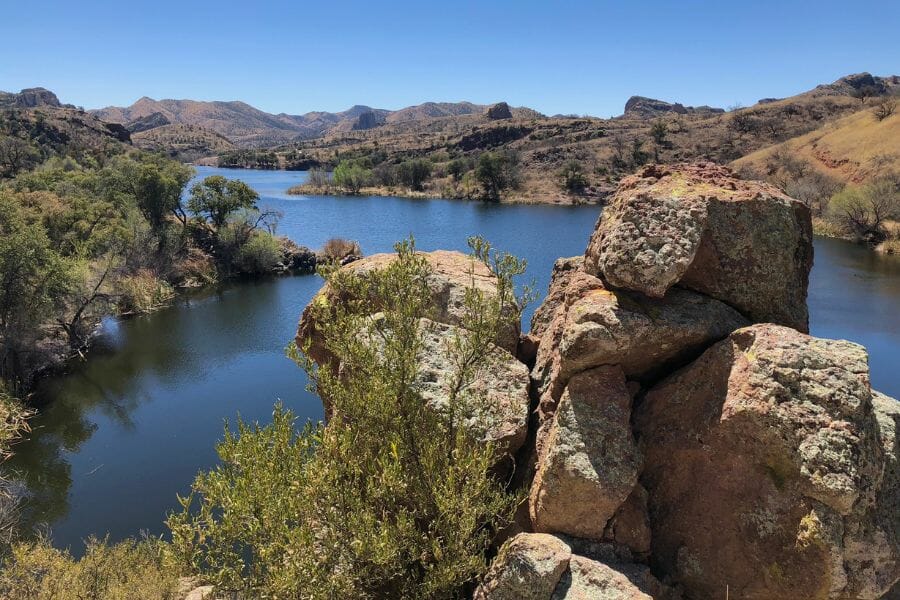
Pena Blanca Lake is a scenic body of water known for its stunning natural beauty and recreational opportunities. Situated in the Santa Cruz Valley, the lake is surrounded by rugged mountains and a pristine desert landscape that provide a perfect backdrop for outdoor activities.
One of the lesser-known attractions of Pena Blanca Lake is the opportunity to find amethysts. The region is rich in mineral deposits, including quartz, which is the primary component of amethyst. The lake was created by damming a nearby creek, and the resulting reservoir has exposed layers of rock that contain amethyst deposits.
Where we found amethyst in Pena Blanca Lake
The best place to search for amethysts near the lake is the hillsides and valleys surrounding the reservoir.
Silver Reef Mountains
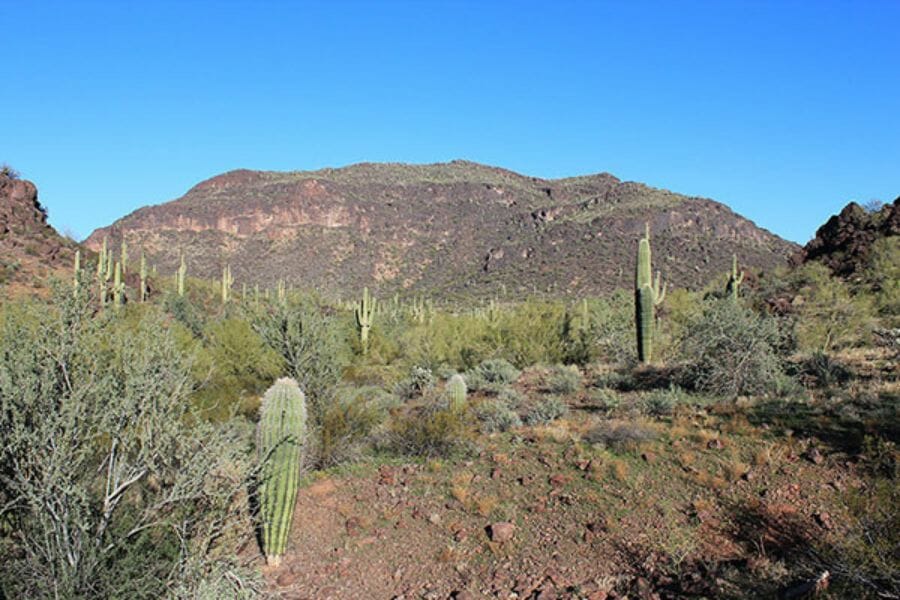
The Silver Reef Mountains are a rugged range in southern Arizona known for its unique geology and abundant mineral deposits. The range covers a vast land area and is known for its dramatic and stunning scenery. It’s a popular destination for outdoor enthusiasts, hikers, and rock hounds alike.
The geology of the Silver Reef Mountains is a key factor in its unique landscape. The area comprises volcanic rock formations shaped and sculpted over millions of years by natural forces such as wind and water. The result is a landscape that’s rich in minerals and natural beauty.
Where we found amethyst in the Silver Reef Mountains
You can explore the Silver Reef Mountains, hillsides, and valleys for amethysts. The best locations for amethyst hunting are typically in areas with exposed rock formations and outcroppings.
Other Great Places To Mine For Amethyst in Arizona
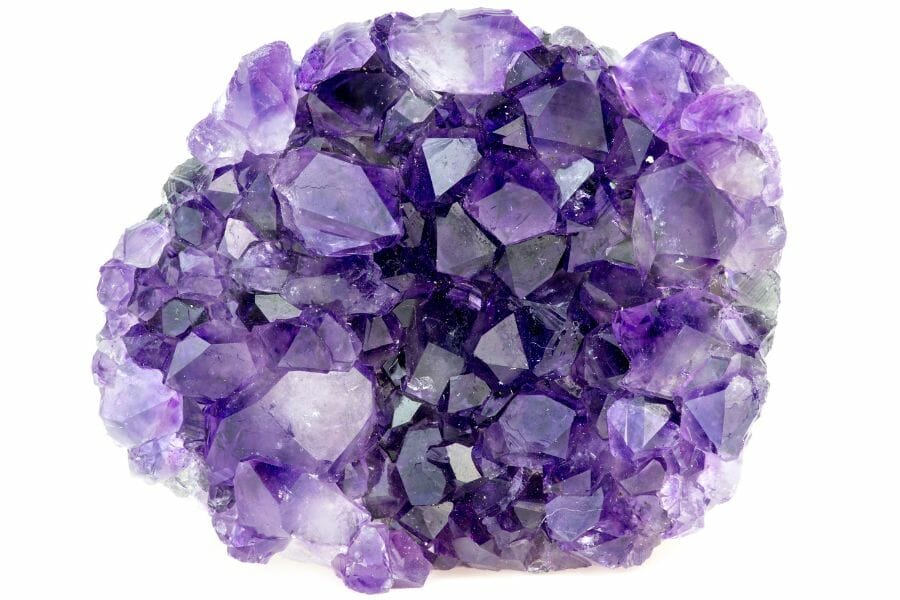
Our recommendations by county
We’ve already included our top recommendations for amethyst locations in Arizona, but there are still many places we can suggest. Below, we’ve sorted them by county to make thing simpler.
| County | Location |
| Cochise | Cole Mine |
| Graham | Ten Strike Mine |
| Maricopa | Amethyst Prospect |
| Navajo | Southeast of Holbrook |
| Pinal | Ajax Mine |
| Pinal | Silver Reef Mine |
| Pinal | White Horse pass area |
| Pinal | Tat Momoli Mountains area |
| Santa Cruz | Big Steve Mine |
| Yavapai | Date Creek |
| Yavapai | Fat Jack Mine |
| Yavapai | Lane Mountain |
| Yavapai | Bradshaw Mountains |
| Yavapai | Constellations area mines |
Common Amethyst-Hunting Questions
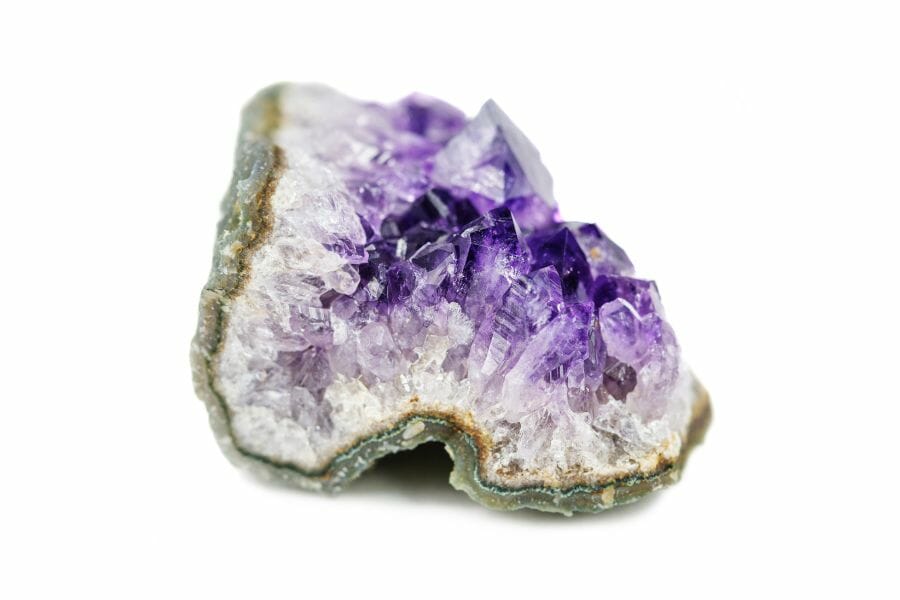
It’s necessary to answer several often-asked questions concerning Arizona amethysts, including the ones listed below:
Where can you find amethyst geodes in Arizona?
Amethyst geodes aren’t found naturally in Arizona, but there are a few rock shops where you might get them, as well as other specimens.
Is it illegal to collect amethyst in Arizona?
Arizona allows amethyst collecting as long as you follow local laws. If you’re on public property, abide by all applicable laws. If you’re on private land, make sure you have the permission.
The Best Places To Buy Amethyst In Arizona
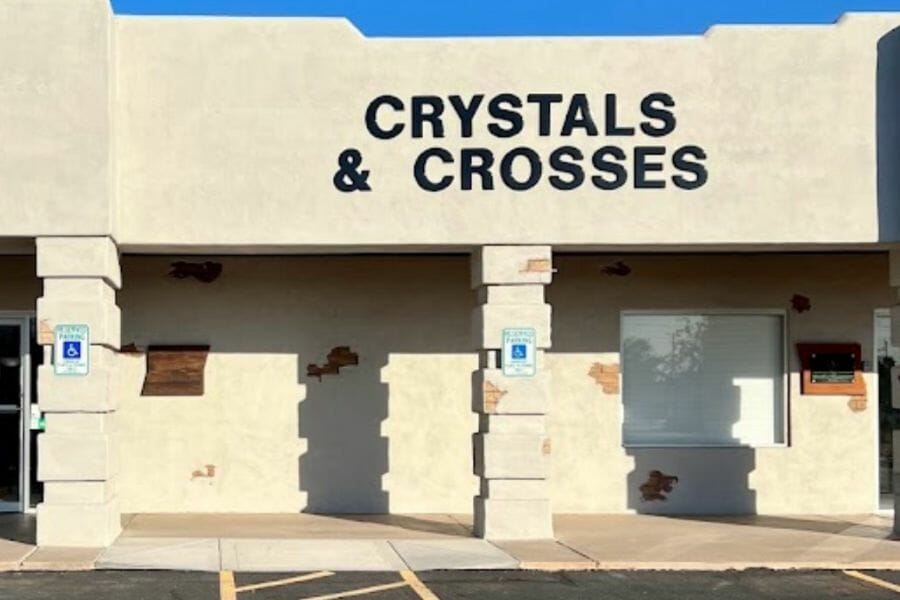
Not everyone enjoys wandering through the woods for hours, looking for amethysts. Sometimes, you only need something attractive and easy to obtain for your workplace or collection. The list of rock shops where you may get amethyst crystals is below.
- Crystals and Crosses – 185 N Apache Trail #8, Apache Junction, AZ 85120
- The Crystal Loft – 1710 N 16th St Unit C2, Phoenix, AZ 85006
- Everything Just Rocks – 2235 W 1st St Unit 104-105, Tempe, AZ 85281
- Star Woman Crystals – near Scottsdale Rd &, E McKellips Rd, Tempe, AZ 85281
- Stones, Crystals, Minerals, Gemstones, and Fossil Shops – 7085 E 5th Ave, Scottsdale, AZ 85251
Additional places to find amethyst in nearby states
Check out the guides we made for the places we think you should also visit once you’ve explored each of the places we listed above to find amethyst in neighboring states:
If you have any recommendations for our list, please leave a comment below!

